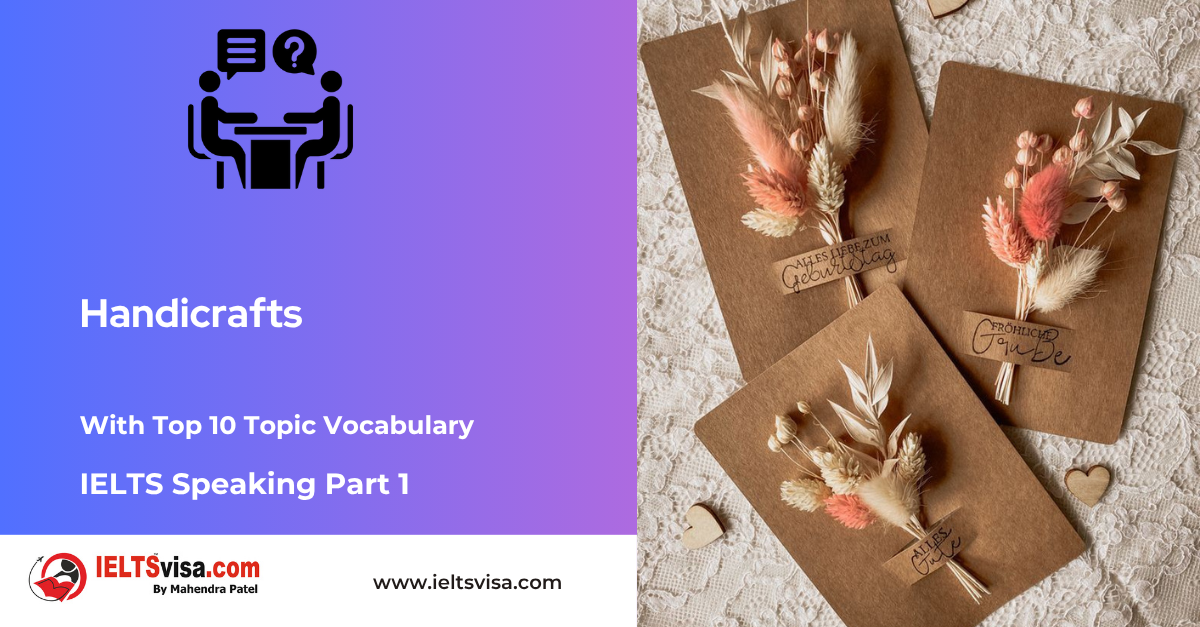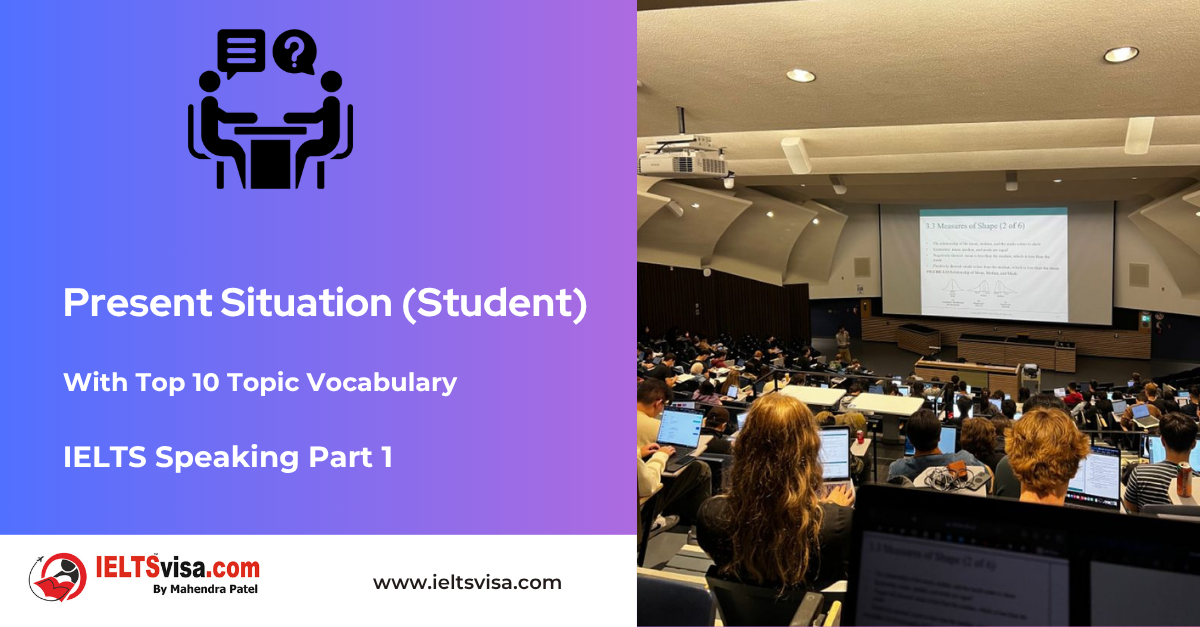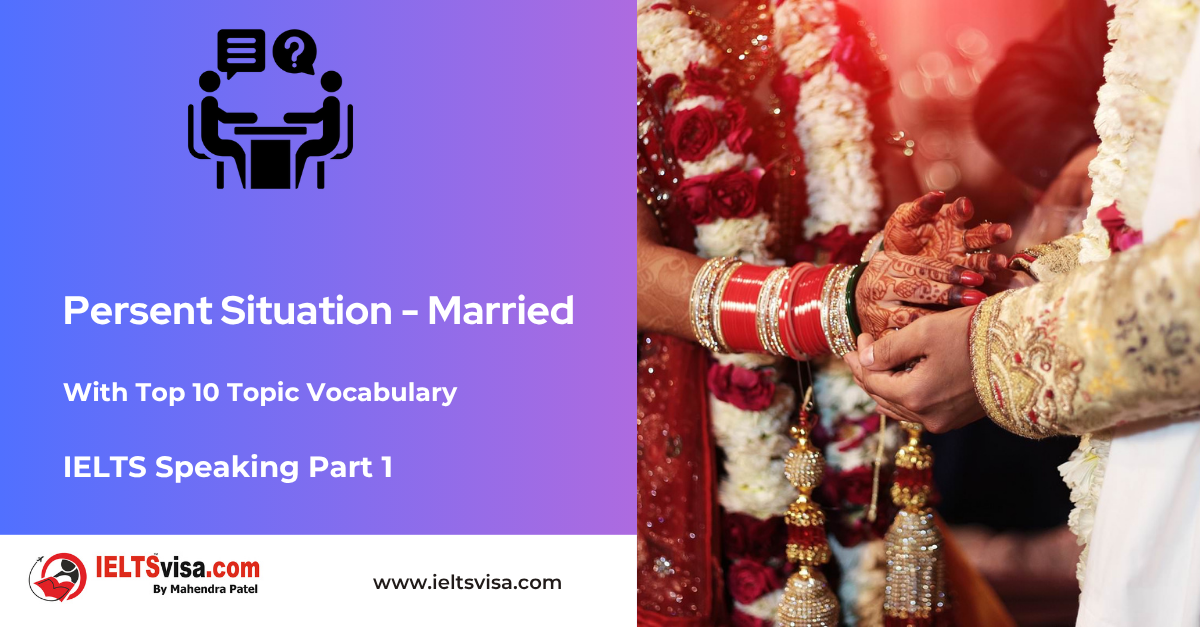IELTS Speaking Part 1 – Handicrafts
IELTS Speaking Practice
IELTS Speaking Part 1 – Handicrafts
Examiner: Do you appreciate handicrafts?
Candidate: Absolutely! I find handicrafts charming and appreciate the skill and creativity involved. They can be beautiful decorative pieces, unique gifts, or even practical items made with care and tradition.
Examiner: Have you ever tried making your own handicrafts?
Candidate: I haven’t necessarily created elaborate crafts, but I might have dabbled in simple jewellery making or basic knitting. While my skills might not be professional, the process can relax and allow me to create something personalized.
Examiner: What kind of handicrafts are popular in your country?
Candidate: The popularity of handicrafts in my country varies depending on the region. Some traditional crafts include weaving textiles, carving wooden sculptures, or embroidery on clothing. These crafts often have cultural significance and represent local artistic traditions.
Examiner: Do you think there’s a growing interest in handicrafts nowadays?
Candidate: There might be a resurgence of interest in handicrafts for a few reasons. People might appreciate the unique and sustainable qualities of handmade goods. The DIY (Do It Yourself) movement also encourages people to learn new skills and create something themselves.
Examiner: Where do you usually buy handicrafts?
Candidate: There are several places to find handicrafts. I might visit local craft fairs, shops specializing in handmade goods, or markets selling traditional crafts. Sometimes, I might purchase directly from the artisans who create the pieces.
Examiner: What makes a good handicraft, in your opinion?
Candidate: A good handicraft combines functionality with aesthetic appeal. It should be well-made, using quality materials and demonstrating the maker’s skill. The design should be pleasing to the eye and potentially showcase a cultural element or unique style.
Examiner: Do you think handicrafts can be valuable souvenirs?
Candidate: Absolutely! Handicrafts make excellent souvenirs as they represent the local culture and artistry. They are often more meaningful than mass-produced items and support local artisans.
Examiner: In your opinion, how can we encourage the preservation of traditional handicrafts?
Candidate: There are ways to preserve traditional handicrafts. Supporting local artisans by purchasing their work is crucial. Additionally, organizing workshops and courses can teach younger generations these valuable skills. Promoting the cultural significance of handicrafts can also help maintain interest in these traditions.
Examiner: Do you think handicrafts can be considered art forms?
Candidate: Absolutely! Handicrafts often involve a high degree of artistic skill and creativity. The techniques and designs can be considered art forms, especially when incorporating traditional methods and cultural symbolism.
Examiner: Do you think handicrafts will always be relevant in our modern world?
Candidate: I believe handicrafts will remain relevant. There’s a growing appreciation for unique, handmade items; the skills involved are valuable forms of artistic expression. While technology might play a role in future craft design, the human touch and creativity will likely ensure the continued significance of handicrafts.
Examiner: Have you ever received a handmade gift that you particularly treasured?
Candidate: I haven’t necessarily received a show-stopping piece, but a handmade gift can be especially touching. The time and effort invested in creating something personal makes it a unique and thoughtful gesture. The emotional connection to the item adds to its value.
Examiner: Do you think learning a handicraft can be an excellent way to relax and de-stress?
Candidate: Absolutely! The repetitive motions and focus required in many handicrafts can be meditative and promote relaxation. Focusing on the creative process allows you to disconnect from daily worries and find a sense of calm. The satisfaction of creating something beautiful with your own hands can also be a mood booster.
Examiner: Are there any specific materials you enjoy working with for handicrafts?
Candidate: I might prefer some materials but wouldn’t necessarily have a favourite. However, some materials might be more user-friendly for beginners, like natural fibres for knitting or clay for simple pottery. Experimenting with different materials can be part of the fun of exploring handicrafts.
Examiner:Do you think the internet has played a role in promoting handicrafts?
Candidate: The internet has definitely played a role in promoting handicrafts. Online platforms like Etsy, craft tutorials on YouTube, and social media communities for artisans connect crafters and buyers globally. They also offer information and inspiration for people interested in learning new skills or discovering unique handcrafted items.
Examiner: In your ideal world, how would you like to see the future of handicrafts?
Candidate: In an ideal future, handicrafts would continue to thrive. They would be valued not just for their aesthetic appeal but also for their contribution to cultural heritage and sustainable practices. Imagine a world where traditional skills are passed down to new generations, and handcrafted items are appreciated for their unique charm and the human connection they represent.
Top 10 Topic Vocabulary for “Handicrafts
|
Vocabulary |
Type |
Meaning |
Synonyms |
Antonyms |
Word Family |
Example Sentences |
|
Appreciation |
Noun |
The act of recognizing and valuing something |
gratitude, thanks, esteem |
appreciate |
I appreciate the handmade gift. I really appreciate the time and effort that went into this handmade gift. |
|
|
Unique |
Adjective |
Existing or occurring only once or in one place; exceptional |
one-of-a-kind, unusual, singular |
uniqueness |
Handicrafts are often unique. Each handcrafted item is unique and has its own special qualities. |
|
|
Cultural |
Adjective |
Relating to or characteristic of a particular culture or group of people |
social, societal, communal |
culture |
Handicrafts often have cultural significance. Handicrafts can be critical to a culture’s history and traditions. |
|
|
Resurgence |
Noun |
An increase in activity or popularity after a period of decline |
revival, comeback, resurgence |
resurgent |
There is a resurgence of interest in handicrafts. There has been a recent resurgence of interest in traditional handicrafts. |
|
|
Artisan |
Noun |
A skilled worker who crafts objects by hand |
craftsman, craftswoman, artisan |
artisanal |
I purchased a handcrafted item from a local artisan. I bought a beautiful handcrafted vase from a local artisan. |
|
|
Aesthetic |
Adjective |
Relating to or concerned with beauty |
artistic, beautiful, visually |
aesthetically |
Handicrafts should be aesthetically pleasing. Handicrafts should be visually appealing and beautiful. |
|
|
Souvenirs |
Noun |
Objects that one brings back after a trip or holiday as a reminder of the place visited |
keepsakes, souvenirs, memorabilia |
souvenir |
Handicrafts make excellent souvenirs. Handicrafts are great souvenirs to bring back from a trip as a reminder of your travels. |
|
|
Preservation |
Noun |
The act or process of keeping something safe or unchanged |
conservation, protection, maintenance |
preserve |
We should encourage the preservation of traditional handicrafts. We should support the preservation of traditional handicrafts to keep them alive for future generations. |
|
|
Therapeutic |
Adjective |
Relating to the healing of disease or the treatment of injury |
curative, remedial, medicinal |
therapy |
Making handicrafts can be therapeutic. Making handicrafts can be a relaxing and therapeutic activity. |
|
|
Sustainable |
Adjective |
Able to be maintained at a certain level without compromising future generations’ ability to meet their own needs |
environmentally friendly, eco-friendly, green |
sustainability |
Handicrafts can be a sustainable source of income. Handicrafts can provide a sustainable livelihood for many people. |

Our Books
Master IELTS Speaking Part 1
IELTS Writing Task 1 Book
IELTS Writing Task 2 Book
Practice IELTS Other Modules
IELTS Listening
The IELTS Listening test assesses how well you can understand spoken English in various contexts. It lasts about 30 minutes and is divided into four sections with a total of 40 questions. The listening tasks become increasingly difficult as the test progresses.
IELTS Academic Reading
The IELTS Academic Reading section assesses your ability to understand and interpret a variety of texts in academic settings. It is designed to evaluate a range of reading skills, including skimming for gist, reading for main ideas, reading for detail, understanding inferences, and recognizing a writer's opinions and arguments.
IELTS Speaking
The IELTS Speaking test assesses your ability to communicate in English on everyday topics. It lasts 11-14 minutes and consists of three parts: introduction, cue card, and a discussion based on the cue card topic.
IELTS General Reading
IELTS General Reading tests your ability to understand and interpret various types of texts. Here are some key areas and types of content you can expect to encounter in the reading section, along with tips for effective preparation.
IELTS Academic Writing Task 1
In IELTS Academic Writing Task 1, you are presented with a visual representation of information, such as graphs, charts, tables, or diagrams, and you are required to summarize, compare, or explain the data in your own words.
IELTS General Writing Task 1
In IELTS General Writing Task 1, you are required to write a letter based on a given situation. The letter can be formal, semi-formal, or informal, depending on the prompt. Here’s a breakdown of the key components to include in your letter
IELTS Academic Writing Task 2
In IELTS Academic Writing Task 2, you are required to write an essay in response to a question or topic. Here’s a guide to help you understand the essential elements of this task
IELTS Exam Tips
To succeed in the IELTS exam, practice regularly, familiarize yourself with the test format, improve your vocabulary, develop time management skills, and take mock tests to build confidence.
Grammer for IELTS
Grammar is the foundation of effective communication in English. Understanding tense usage, subject-verb agreement, and sentence structure enhances clarity and coherence in writing and speaking.
Vocabulary for IELTS
Vocabulary plays a crucial role in the IELTS (International English Language Testing System) exam, especially in the Speaking and Writing sections. Here’s an overview of why vocabulary is important and how it impacts your performance
RECENT IELTS SAMPLES QUESTIONS AND ANSWERS
IELTS Speaking Part 1 – Favourite Sujbect – Physics
IELTS Speaking Part 1 - Favourite Sujbect - Physics Q: What is your favourite subject? A: My favourite subject...
IELTS Speaking Part 1 – Present Situation (Student)
IELTS Speaking Part 1 - Present Situation (Student) Q1: Are you a student or do you work?A: I’m a full-time...
IELTS Speaking Part 1 – Present Situation – Employee – as an International Student and Social Worker
IELTS Speaking Part 1 - Present Situation - Employee - as an International Student and Social Worker Q1: Are...
IELTS Speaking Part 1 – Persent Situation – Employee- as an Electric Engineer
IELTS Speaking Part 1 - Persent Situation - Employee- as an Electric Engineer Q1: What do you do for a...
IELTS Speaking Part 1 – Persent Situation – Employee – as an Software Engineer
IELTS Speaking Part 1 - Persent Situation - Employee - as an Software Engineer Q1: What do you do for a...
IELTS Speaking Part 1 – Persent Situation – Married
IELTS Speaking Part 1 - Persent Situation - Married Q1: Are you married?A: Yes, I am married. My spouse and I...













